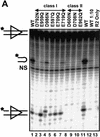Mutational analysis of RAG1 and RAG2 identifies three catalytic amino acids in RAG1 critical for both cleavage steps of V(D)J recombination
- PMID: 10601032
- PMCID: PMC317185
- DOI: 10.1101/gad.13.23.3059
Mutational analysis of RAG1 and RAG2 identifies three catalytic amino acids in RAG1 critical for both cleavage steps of V(D)J recombination
Abstract
RAG1 and RAG2 initiate V(D)J recombination, the process of rearranging the antigen-binding domain of immunoglobulins and T-cell receptors, by introducing site-specific double-strand breaks (DSB) in chromosomal DNA during lymphocyte development. These breaks are generated in two steps, nicking of one strand (hydrolysis), followed by hairpin formation (transesterification). The nature and location of the RAG active site(s) have remained unknown. Because acidic amino acids have a critical role in catalyzing DNA cleavage by nucleases and recombinases that require divalent metal ions as cofactors, we hypothesized that acidic active site residues are likewise essential for RAG-mediated DNA cleavage. We altered each conserved acidic amino acid in RAG1 and RAG2 by site-directed mutagenesis, and examined >100 mutants using a combination of in vivo and in vitro analyses. No conserved acidic amino acids in RAG2 were critical for catalysis; three RAG1 mutants retained normal DNA binding, but were catalytically inactive for both nicking and hairpin formation. These data argue that one active site in RAG1 performs both steps of the cleavage reaction. Amino acid substitution experiments that changed the metal ion specificity suggest that at least one of these three residues contacts the metal ion(s) directly. These data suggest that RAG-mediated DNA cleavage involves coordination of divalent metal ion(s) by RAG1.
Figures










References
-
- Agrawal A, Eastman QM, Schatz DG. Transposition mediated by RAG1 and RAG2 and its implications for the evolution of the immune system. Nature. 1998;394:744–751. - PubMed
-
- Allingham JS, Pribil PA, Haniford DB. All three residues of the Tn10 transposase DDE catalytic triad function in divalent metal ion binding. J Mol Biol. 1999;289:1195–1206. - PubMed
Publication types
MeSH terms
Substances
Grants and funding
LinkOut - more resources
Full Text Sources
Other Literature Sources
Molecular Biology Databases
